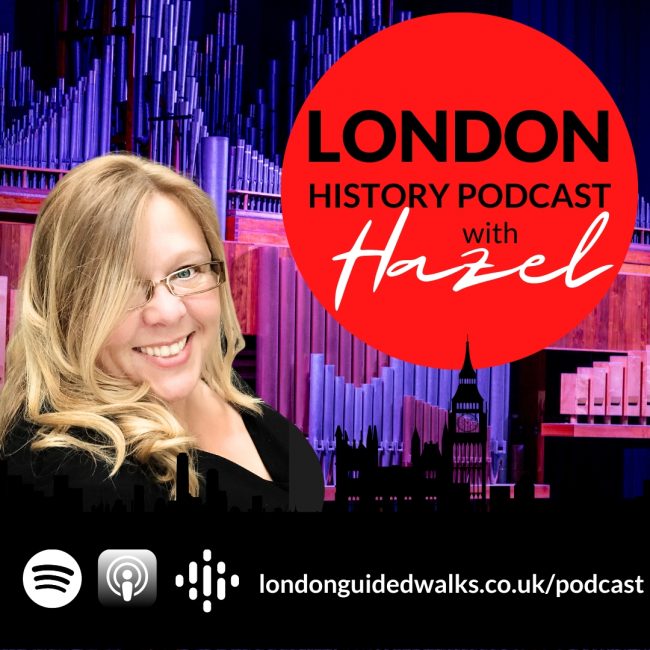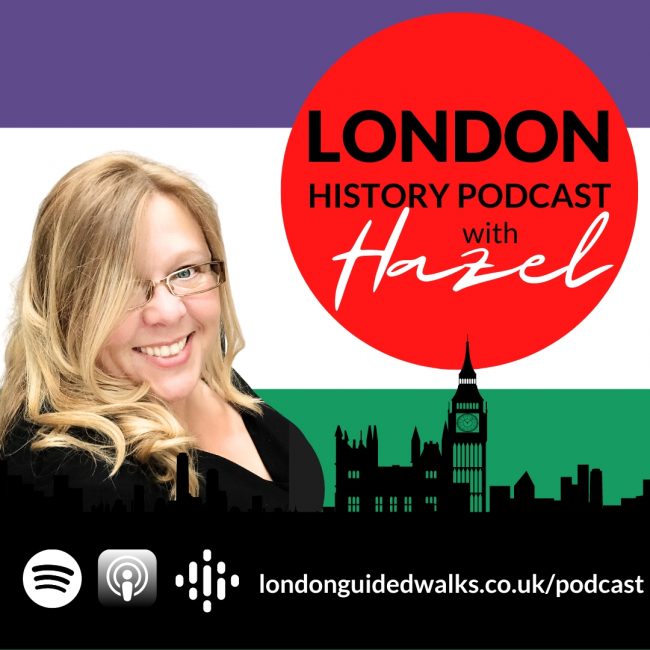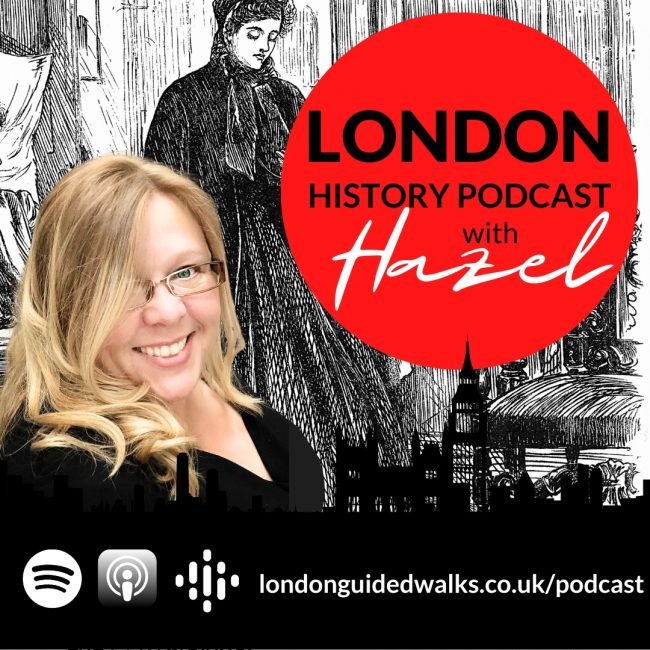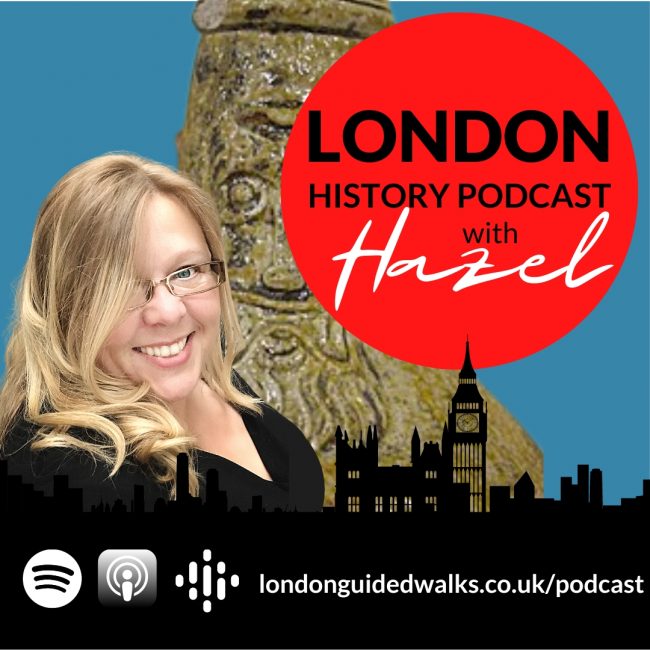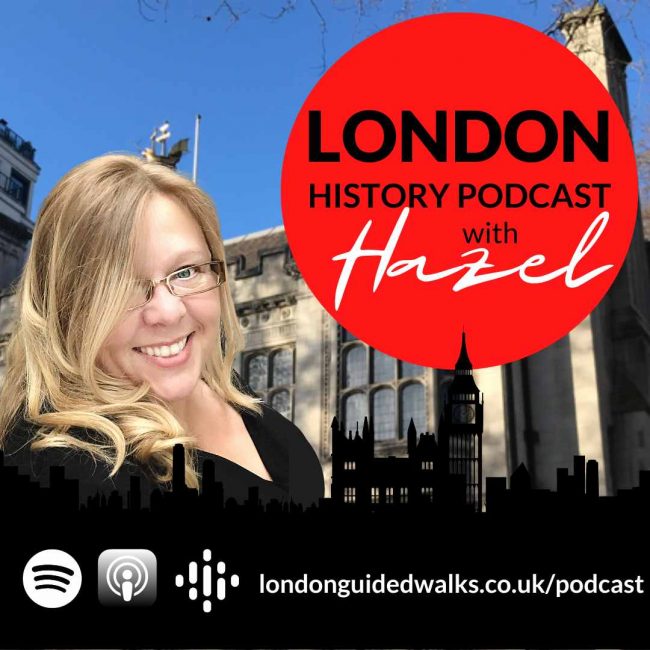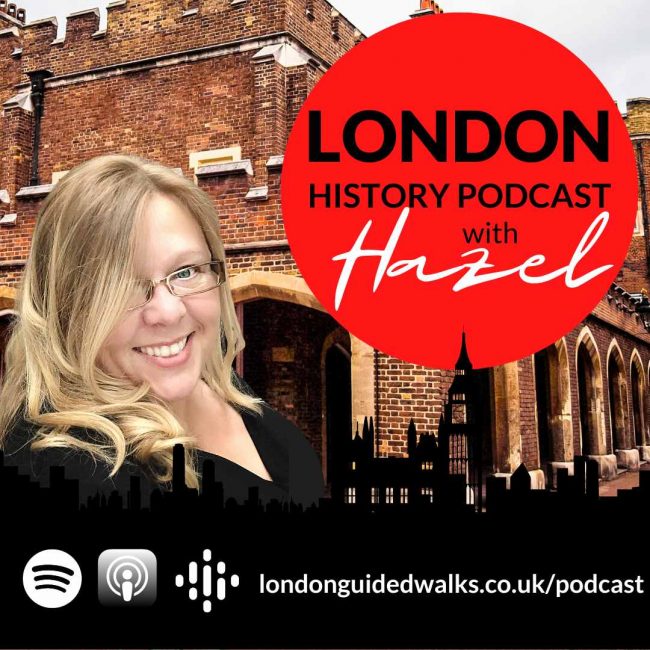Recommended Reading:
Show Notes:
 Hazel Baker: Hello and welcome to London Guided Walks London History podcast. In the coming episodes, we will be sharing our love and passion for London, its people, places and history in an espresso shot with a splash of personality. For those of you who don’t know me, I am Hazel Baker, founder of London Guided Walks, providing guided walks and private tours to Londoners and visitors alike.
Hazel Baker: Hello and welcome to London Guided Walks London History podcast. In the coming episodes, we will be sharing our love and passion for London, its people, places and history in an espresso shot with a splash of personality. For those of you who don’t know me, I am Hazel Baker, founder of London Guided Walks, providing guided walks and private tours to Londoners and visitors alike.
And don’t forget, our blog is regularly updated with posts written by our passionate team of qualified London tour guides and there are hundreds to choose from, all absolutely free. So without further ado, let’s get on with the show.
2020 and beginning of 2021 haven’t been all that fun. But you know what? We have had it worse. Joining me in the studio today is City of London tour guide Ian McDiarmid and we are going to be talking The Black Death. Hello!
 Ian McDiarmid: Hi there. Yeah, this should cheer everybody up.
Ian McDiarmid: Hi there. Yeah, this should cheer everybody up.
Hazel Baker: The Black Death is the name given to the first wave of the plague that swept across Europe in the 1300s. It was the deadliest pandemic recorded in human history. It resulted in the deaths of up to 75 to 200 million people in Europe, Asia and North Africa peaking in London from 1348 to 1349. The Black Death was the result of a highly infectious disease spread by fleas, that bit their hosts, usually rats and humans and introduced the bacteria Yersinia Pestis that caused the disease into their hosts’ bodies. Now Ian, considering the size of these tiny, tiny fleas, how did they manage to do so much damage?
Ian McDiarmid: Very good question. And it’s one that baffled scientists at the beginning of the 20th century, if we go to the 1890s, there was an outbreak of plague in China in 1894.
And Europe sent its the best epidemiologists over to study this outbreak. And these included a French by the name of yes, sir. And he’s the one who identified the bacteria responsible and the disease, since we known as your senior pestos after him. But there remained a big problem, that was how the disease was actually transmitted the plague.
This outbreak in China moved to India. And in India, there was something called the India leg research commission. And it was their work at the beginning of the 20th century that established it. Initially, they thought, well, it might’ve been transmitted directly from human to human then they thought maybe human fleas did it.
And then they began investigating rat fleas. But the problem with fleas is that if they bite a human, humans are very big first of all. So you’re not going to get very much bacteria out of a flea bite of a human. And secondly, the fleas themselves are very, very small. They’ve got very small stomachs and their noses, whether it be biting, their probostskiis are small as well.
So it’s a bit of a puzzle how you get enough disease material in from a flea bite. But they nailed it down eventually. They nailed it down to rat fleas rather than human fleas as the vector for the disease. And one significant thing about the way the disease progresses is that when it infects a flea and we’re talking about the fleas of black rats; rattus rattus, it causes a blockage in their stomachs and this blockage causes them to regurgitate a lot of the bacteria into the bite wound that they’re making. And this is how the disease gets going. And it’s also very important this blockage in the stomach, because it means that the disease maintains its virulent character.
Hazel Baker: Why is that?
Ian McDiarmid: You need a verbal form of the plague to cause this blockage in the fleas’ tummy.
Hazel Baker: Oh. So we know how it’s caused now, but when in 1349, what did they think?
Ian McDiarmid: The main explanation for it was that it was God’s punishment for the sins of mankind. And when they knew that the plague was on its way or when it originally broke out, one of the principal reactions of it was to have these religious processions to show penitents and to try and ward off the disease. Another explanation of it was that it was due to some kind of pestilence in the air that it was associated with some kind of rottenness in the air. A bit like miasma would be would be used to explain the plague later on in the 17th century.
And then they could also come up with other explanations. Notable one being astrology. The University of Paris was, after the outbreak, asked to explain what caused this terrible disease. And they went back and looked at their charts and they noted conveniently that there was some cataclysmic event in the heavens just before it all happened.
So they, they had various ways of explaining it. What they didn’t know about crucially was fleas.
Hazel Baker: I had read that the King had requested that London’s streets being cleaned and the response was that they couldn’t because the street cleaners had already died of the place.
Ian McDiarmid: Oh, okay. That’s interesting. One of the things that affects London is that there are subsequent outbreaks and there’s one in 1361. And Edward III issued this ordinance, which we talk about one of our tours, actually, when we go around the shambles, which was the meat market around the new gate area. He issues an edict saying you will not slaughter animals within the city of London. And it was because of all the awful and everything that was created by the slaughtering of the animals. And this shows this concern with bad smells, bad air being a possible cause
Hazel Baker: Yeah, your medieval walks’ a very good one by the way.
Ian McDiarmid: Oh, thank you. Yeah, I enjoy doing it.
Hazel Baker: So here’s a big one. How did the black death get its name?
Ian McDiarmid: It feels as though it ought to be descriptive. It feels as though it ought to be describing the symptoms of the people who suffered from the disease and in a way, unfortunately, the answer is no. Phillip Siegler who wrote a very good textbook, still the textbook in 1969, he offered an explanation for how this name came around and he says that it’s a later invention, but contemporary didn’t use it. And he speculates that it’s a mistranslation of the Latin atra mors, atra can mean black, but it can also mean dreadful. So it was probably just as a description dreadful death.
Hazel Baker: I think that sounds even better. The dreadful deaths don’t you?
Ian McDiarmid: Yep. I agree. We are stuck with black death and like a lot of historical terms. It’s one for convenience, everybody knows it. So we’re just going to carry on using it.
Hazel Baker: You kind of hinted about the name being descriptive and we have these buboes didn’t we?
Ian McDiarmid: Yes. So the main symptom of bubonic plague is the development of these boil-like buboes at the end of the lymphatic system. So, the way bubonic plague is an infection of the lymphatic system. Typically you’d be bitten on the leg and you develop these buboes in the groin or on the thigh. But if you’re bitten a bit higher up, you could well develop buboes in other lymphatic nodes. So the armpit, on the neck, behind the ear.
And what would happen is that the disease from the initial bite would take about two to five days to incubate before you started feeling the symptoms, and then you’d feel unwell and you’d be dead within two to five days. Probably. Now, I know that you disagree with this, but I’m going to say stick with my figure of 80% mortality for bubonic plague , though I can actually speak for you and say that you think that it was much lower don’t you?
Hazel Baker: Yeah, the bubonic I’ve read 50%, whereas this septicemic and the pneumonic is near to a hundred percent.
Ian McDiarmid: Okay. Well, I’m sticking with my 80%. But anyway, what Hazel’s just mentioned is that there are two further varieties of bubonic plague ; pneumonic and septicemic. So I’ve said that bubonic is an infection of the lymphatic system. What could happen is that if the attack was very virulent, the disease could spread out into the bloodstream and then you’ve got septicemic plague and, or it could spread out into the lungs. In which case you’ve got pneumonic plague. And with these, you don’t get the buboes unless you’ve got bubonic plague as well.
With the septicemic, you’d get kind of blotches under the skin and then you’d be dead very quickly. Pneumonic you would be spitting blood towards the end and you’d have blood coming out of your nose as well.
So it was quite easy to identify. And when we’re talking about the disease sort of spreading out from the lymphatic system, we are then talking about secondary pneumonic plague, one of the characteristics of pneumonic plague is that we’ve said, that the disease need a flea to transmit it.
Pneumonic plague can be transmitted directly from human to human. So if you breathe in the droplets of somebody’s coughing and they’ve got pneumonic plague, or you come into contact with their sputum, you can contract pneumonic plague. And if you contract it directly from somebody without getting a bubonic plague, then it’s known as primary pneumonic.
Hazel Baker: Yeah. And I have recently read an article, which suggests that London had a combination of bubonic and pneumonic to deal with.
Ian McDiarmid: Yeah, my understanding is that that there would have been these other varieties septicemic and pneumonic, but they would have played a minor role. The majority of people would be bothered, but we have to say that there’s a huge debate over this.
And I mean, it’s enormously difficult to use medieval documents. All in fact, it’s very difficult to use any documents really from before the development of modern medicine and be precise about people’s symptoms. So there’s a lot of debate about it. And perhaps we should mention if we haven’t done already, but there’s an awful lot of debate as to whether it was actually Yersinia Pestis.
We’re running with it as Yersinia Pestis, but there’s a lot of literature saying that it was actually some other illness that killed everybody off.
Hazel Baker: So Ian, what did the authorities try to do to stop The Black Death?
Ian McDiarmid: Well unfortunately, here we’re limited by our sources. One of the frustrating things about The Black Death is as you described it, it’s the biggest disaster in a way to affect Western Europe. But the sources in general are fairly patchy. And for London, we don’t really have any ordinances saying that the government is saying to people, the government of London is instructing people to do this and do that. We don’t have that. What we have got is a lot of information from Italian cities and Italian cities where the government was very well-developed though they were the wealthiest cities in the world. They had the greatest, the most developed bureaucracies, and we’ve got a lot of information from them. And in the link, we’ll include a book edited by Rosemary Horrocks where she brings a lot of these sources together. And that’s one of my favourite books on this subject.
And one of the documents that she has in that book is a list of ordinances from Pistoia and in Pistoia there, they’re doing all the kinds of things that you might expect with an outbreak. They’re limiting, they’re saying you cannot go in and out of the city, you cannot come into the city. You cannot trade in second-hand cloth. There are instructions about burials and all the rest of it. And we don’t have this in London, but we can infer that the London government was doing something and we can infer that from the emergency cemeteries that were created.
So there were three of them. There was one in West Smithfield, one in Clerkenwell, associated with St Paul’s, and one to the East, which is known as the East Smithfield cemetery, also the church out of Holy Trinity priory. The fact that they made these emergency cemeteries indicate obviously they had a big, big problem with a very, very large number of deaths.
Some of the archaeologists looking at this have also speculated that there’s an increased frequency of the use of wooden coffins. And this is something that they are big on in Italy. For example, in Pistoia they say, if you’re burying the dead, you must do so in a wooden coffin.
So that means expense. But the idea is that if you got a container around the body, you are in some way of trying to contain the disease. So we can look at that and we can infer that the city authorities were taking action. And one of these emergency cemeteries that’s in East Smithfields, they did a big excavation in the 1980s. And you know quite a lot about that. So can I ask you about what they found when they did the dig there?
Hazel Baker: You might be surprised to learn that they found bodies. Yeah, a total of 636 individuals. And they were in two areas of this emergency cemetery and they found them in both in mass graves and then also individual burials as well, which I was surprised to learn ‘cos I would have thought they would have just been placing them in as quickly as they possibly could, because were here, accounts of 20, 40, 60 bodies being buried at any one day. That’s a lot of bodies to bury, isn’t it?
Ian McDiarmid: It is. And I guess that when they’ve buried them individually, they’ve got time to do it. And when they’re doing a sort of mass burial, it’s obviously the cartloads coming into the cemetery. However, I’m right on time saying that even when they’re doing them in the mass graves, they’re just not sort of, they’re not tipping them in by wheelbarrow, that’s in care, over a range.
Hazel Baker: Yeah. And that, and that’s the imagery that you get from TV and even some books that I’ve read, but no they’re actually properly placed and give them respect and they even have shrouds.
Ian McDiarmid: Yeah. So that they’re facing the right way. So on the day of judgment, when they rise up, they’re facing the right way.
Hazel Baker: That’s right. They don’t have to turn around.
Ian McDiarmid: No, that’s right.
Hazel Baker: Yeah. So this cemetery, so this was purely an emergency one for The Black Death. It covered an approximate area of two hectares. They are still estimating that 40 to 50% of the cemetery is still in situ. They haven’t looked at that yet.
Ian McDiarmid: Wow.
Hazel Baker: So there’s plenty for future archaeologist to get stuck into.
Ian McDiarmid: Yes, in the Charterhouse Square excavation, which I was mentioning earlier on where they just basically have done a tiny sample through the Crossrail work. The estimates are that there are between two and 20,000 people buried there. So very wide range of estimates, but obviously it’s a very, very large cemetery.
Hazel Baker: Yeah. Well, what they found with the demographic profiling of this emergency cemetery, they found that 27.8% of the burials were juveniles. And most of those are over five years of age. So that leaves the 72.2% being adults. However, the majority of adults there had died before they reached the age of 35.
Ian McDiarmid: So it tentatively shows that the way the disease kills people who are, you would assume being relatively good health.
Hazel Baker: Yes, it’s a cross section of the population. It’s not the richer, the poor, or good diet or bad diet. Even though I have read articles saying that diet did help keep people healthy, but no matter the age, if you are going to get it, you were going to get it.
Ian, you mentioned about not having very much information for London specifically, but what sources do we have ?
Ian McDiarmid: Sources that we have are obviously very helpful. So the things that we’ve got are a lot of information about wills. So, in London, there was the course of Husting, which is the according to the County cause. And the wealthy would draw up wills in this course and they would then subsequently have them enrolled. So after they died, that’s the kind of official registration of the will.
And there are problems with this information. Sometimes the court wasn’t sitting, but nevertheless, the volume of wills being drawn up, people tend to draw their wills up just before popping their clogs. And you obviously, if you had the plague, you’d know you’re about to go. And this day, you can see that from the volume of wills being drawn up on wills being enrolled, you can roughly trace the progress of the disease.
England as a whole, that’s excluding London is very good for sources, relatively, very good for sources. And most of the studies of The Black Death in the European context rely heavily on this English material in the quality of the evidence in England as a whole comes from institutions, which we don’t have for London. Institutions when people appointed to religious offices. So if they’ve died there’ll be an increase in these institutions.
The other big source for England as a whole is Manorial court roles. Very good source of information. When a tenant dies, it’s recorded in the court role. So again, you can monitor the progress of the disease. Now, because saying we don’t have these institutions for the Memorial court roles. We’ve got the problem that people in London, weren’t living in manors. However, there were some manors in the immediate vicinity of London and in particular, there was a very large one at Stepney, which belonged to the Bishop of London. And then again, you can use the evidence from that to sort of roughly track the progress of the plague.
So I think it’s what we were saying earlier again, there’s debates about all of these things, but it probably begets going September/October 1348 goes to the winter. Big debate, whether it slows down in the winter or gradually builds up. And then it reaches a climax in March time, March / April, before dying out in the summer of 1349.
Hazel Baker: So the most of the damage was done by summer at 1349. But what were the consequences of this for London and Londoners?
Ian McDiarmid: Well, the effect can be broken down into a lot of people dying and London becoming a lot emptier, I guess. In terms of population we’ve got quite a good handle, by medieval standards, and what the population was in the late 14th century poll tax records from 1377 indicate population around 40,000.
And there’s a middle area of guesses for before the plague or about 80,000. So, pretty dramatic collapse in the population.
Hazel Baker: And then we must say that that’s actually more dramatic in London, isn’t it? Where 50% of the population go compared to a third England-wide.
Ian McDiarmid: Yeah. Yes, yes, indeed. There are various other consequences that fall from this, this huge human tragedy.
One is that presumably the city is a lot empty and now we don’t have a lot of direct evidence for this, but in 1357, the Londoners petitioned the King Edward III saying that their tax burden should be lightened. And they mentioned in this petition that the city is one third of the buildings are empty. Now, special pleading? Yes. But on the other hand it seems quite plausible. And also they’re not that far away from Westminster, so they can’t really dress it up too much. They can’t divert from reality too much.
One of the immediate effects is that with this collapse in the population, you’ve got a shortage of laborers. It’s very difficult to find people to do the work for you and that they demand more money. And one of the first things that Edward does during the plague itself is to issue the ordinance of labourers in which he says laborers cannot work for more than they did before the plague. And then this becomes the statute of labour is a bit later on.
Now people are prosecuted under this. So action is taken, but the fact that they repeat it or the ordinance becomes a statute. And then I think it becomes reissued indicates that it wasn’t really very effective and the price of labour went up and we can also see the price of a lot of commodities going up as well. Basically with fewer people around labourers, earning more money, the common sort of people are wealthier. They’ve got more money to spend and things like salt, go up in price. We can see the price of salt doubling in London.
Hazel Baker: Even after 671 years, The Black Death has left its mark on London, reminding us of the devastation that disease can inflict on communities.
If you’ve visited Westminster Abbey, you may have noticed a large slab in the Southern cloister. This is believed to cover the remains of the Abbot of Westminster and 27 of his monks who were taken by The Black Death.
And I’ve got some news as well in, as a consequence of all of our hard work for this lockdown podcast. We have now reached 20,000 downloads.
Ian McDiarmid: Oh very good!
Hazel Baker: Yeah. So thank you very much for your contributions and thank you very much for everybody listening. And don’t forget, this is absolutely free. So share the love of London and our London History Podcast with your friends and family. We’ll see you next week for something a lot more fun!


 Hazel Baker:
Hazel Baker:  Ian McDiarmid:
Ian McDiarmid: 